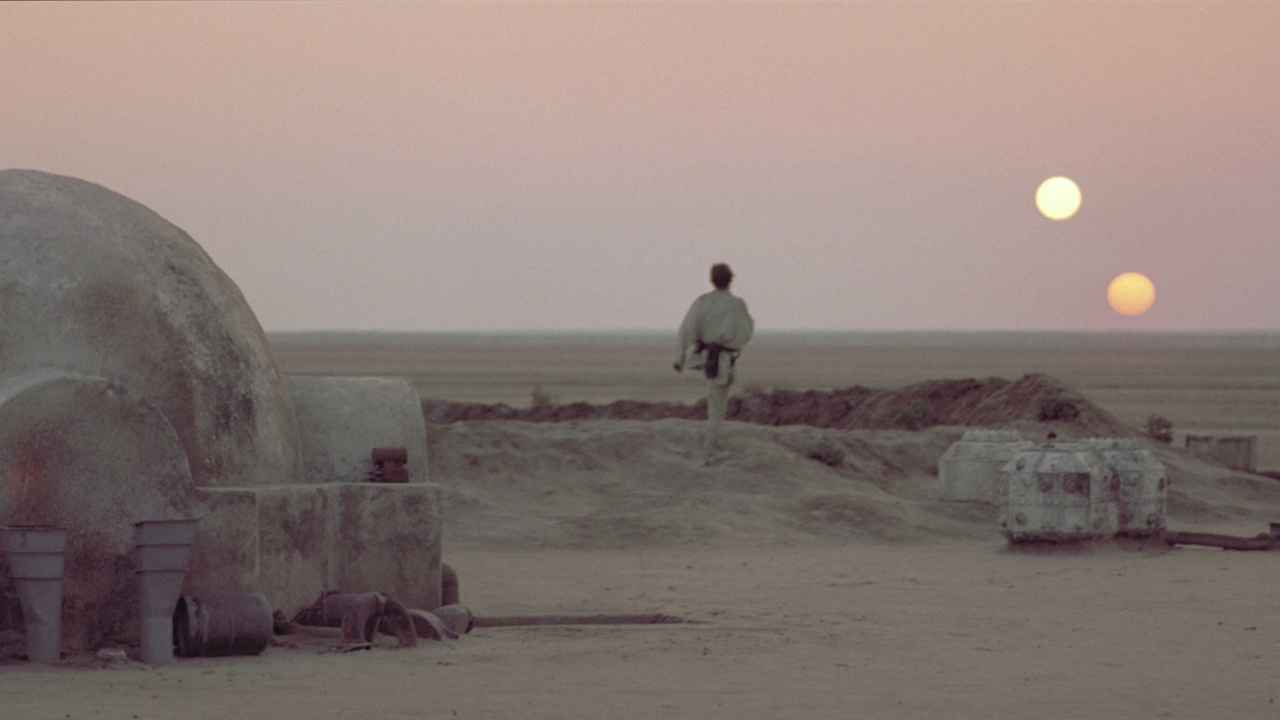Star Wars
Rating
![]()
Director
George Lucas
Screenplay
George Lucas
Length
2h 01m
Starring
Mark Hamill, Harrison Ford, Carrie Fisher, Peter Cushing, Alec Guinness, Anthony Daniels, Kenny Baker, Peter Mayhew, David Prowse, Phil Brown, Shelagh Fraser, James Earl Jones (uncredited)
MPAA Rating
PG
Review
Ascetic monks and hermits. These are probably the only two types of people who have never heard of Star Wars. For everyone else, it’s something of a right of passage.
A lot of people and critics can recall the exact moment they saw the 1977 original in theaters. Some of us don’t remember when specifically, just the general timeframe of it. My first time was sometime in the 1980s. I hadn’t even turned two yet when the film originally released, so if I saw it I don’t remember it. I do remember seeing Empire Strikes Back and Return of the Jedi in theaters when they released but not the original. It was likely during one of its multiple re-releases in the 1980s but I cannot specify which one. I did review the special edition in 1997 but never the original film. Is there enough of a difference between the two? Perhaps not but it’s interesting to look back at what some of us saw at the time as a stunning trilogy that didn’t need to be expanded upon.
Historically, that 1997 re-release wasn’t just about improving the visual effects to the point director George Lucas had wanted with the original film, it was a calculated move to remind viewers of what was coming just a few short years later with the release of the prequel trilogy. At the time, the effects weren’t even that improved but, like Blade Runner, the myriad versions of this film have allowed different viewers to see the merits in each, even if they seldom agree. For me, I don’t really see the revisions in 1997 as terribly revolutionary, though some of the myriad later adjustments were quite frustrating.
This review isn’t about the special edition or the edition that added a force ghosts of Anaki or any number of other changes that have pleased some fans and irked others. This is a review of the original, its then-progressive visual effects, and its sci-fi adherence to the hero’s journey arc with basis in spaghetti westerns, samurai films, and other literary and sci-fi influences. Western, samurai films, and sci-fi don’t seem like they would work together well but Lucas proved otherwise.
Imperial Senator Leia Organa (Carrie Fisher) has uncovered plans for a planet-destroying superweapon and manages to smuggle it out of an Imperial star destroyer with her protocol droid C-3PO (Anthony Daniels) and astromech droid R2-D2 (Kenny Baker) while being captured herself. Meanwhile, Luke Skywalker (Mark Hamill) is a simple moisture farmer on the desert planet of Tatooine with his aunt and uncle where C-3PO and R2-D2 crash land. Through a recording in the R2 unit, he takes the droids to neighbor Obi-Wan Kenobi (Alec Guinness) who helps them flee the planet and sets Luke on his journey to discover his Jedi powers. Pursued by the Empire, Luke teams up with Han Solo (Harrison Ford) and Chewbacca (Peter Mayhew) as they attempt to rescue Leia and destroy the Death Star before it can be used to destroy any other planets.
Lucas had made his auspicious debut with American Graffiti, which gave him the gravitas to get this film made. It wasn’t a sure thing and a risky big-budget effort could have destroyed his career. Luckily for him, he had enough forethought to deliver a compelling film with plenty of action and excitement along with stellar production values. Its cinematic literacy is strong and many of the films it has been influenced by and has subsequently influenced is staggering and impressive. This kind of historical cinematic influence helps construct a narrative production that can be universally appealing. Building on the backs of your predecessors while doing something new with the material elevates a picture like this. Some directors (J.J. Abrams) could learn a lesson or two from this series of films that he reveres because he’s yet to be able to pull it off himself.
Are the characters in Star Wars thinly drawn? Are the storylines familiar? Are most of the performances a bit mediocre? Are the uniformity of each planet’s ecosystems unrealistic? Yes to all of them. That doesn’t matter. What matters is the film is enjoyable. You can root for the good guys, snarl at the bad guys, and experience the thrills of a grand adventure told well. It’s such a lusciously enveloped film from the inventive and voluminous production design to the simple yet character-defining costume design that some of the weaker elements can be forgiven. When you compare it to everything that came after, with a couple of exceptions, you soon realize just how monumental this achievement was and how important it could be in creating a gateway to future filmmakers, which is clearly what happened here.
Star Wars is a cultural phenomenon. Is it a perfect movie? Certainly not, but few are. It’s the perfect synthesis of form and function that takes the audience to exciting places and leaves them wanting more. There’s a reason the film has stayed at the core of public consciousness for almost 50 years.
Review Written
April 4, 2024



















Leave a Reply